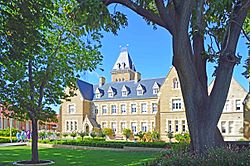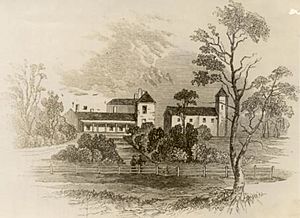Education in Tasmania facts for kids
| Department for Education, Children and Young People | |
|---|---|
| Minister for Education | Jo Palmer |
| General details | |
| Primary languages | English |
| System type | State |
| Compulsory education | 1868 |
| Enrollment (2023) | |
| Total | 55,359.9 FTE |
| Primary | 31,309.6 FTE |
| Secondary | 24,050.3 FTE |
| Attainment | |
| Secondary diploma | Tasmanian Certificate of Education |
The education system in Tasmania helps kids learn from their early years all the way through school and beyond. It includes kindergarten, primary school, high school, and even university or special training colleges. Both government schools and many private schools, often linked to religious groups, are part of this system. The Department for Education, Children and Young People mainly runs public education in Tasmania. This department looks after schooling, adult learning, the State Library, and TasTAFE, which offers job-focused training across the state.
Education in Australia gives a general look at how education works across Australia.
Contents
History of Education in Tasmania
Tasmania has a rich history in education. The very first university-level school in Australia was Christ College. It started in Bishopsbourne, Tasmania, in 1846. Today, Christ College is a place where students live while studying at the University of Tasmania. The University of Tasmania itself began in 1890, making it the fourth oldest university in Australia.
In 1868, Tasmania made history by being the first Australian colony to make education compulsory. This meant that children had to go to school. Later, in 1885, the Tasmanian Department of Education was created. This department was set up to specifically manage education for everyone. In 1908, Tasmania also stopped charging fees for compulsory schooling. This made education free for all children.
Early Learning Programs
The Tasmanian Education Department has a program called "Launching into Learning." This is a free program for very young children, from birth up to four years old, and their families. It helps parents and children get to know their local school and meet other families. You can find "Launching into Learning" programs in all Tasmanian Government primary schools, district schools, and Child and Family Centres.
Primary School Education
Most Australian states have two main levels of schooling: primary and secondary. But Tasmania has a slightly different system with three levels. These are primary school, high school (for students in Years 7 to 10), and colleges (for students in Years 11 and 12). Some colleges even offer an optional Year 13.
Children can start kindergarten if they are four years old by January 1st of that year. If a child is identified as very gifted, they might start kindergarten earlier. They must be at least three years and six months old by January 1st. Students begin their first official year of school, called preparatory, in the year they turn six. They spend seven years in primary school before moving on to high school, just like in other states.
Secondary School Education

In Tasmania, students in Years 11 and 12 can earn the Tasmanian Certificate of Education (TCE). They can also complete vocational education and training, which teaches skills for specific jobs. Unlike other states, Tasmania has separate schools called colleges just for the final two years of high school. Students attend high schools for Years 7 to 10. However, district schools and many private schools combine primary, high school, and college education on one campus. This depends on what the school and community need.
There have been discussions about this system. Some worry that not all Year 10 students continue to college to finish their secondary education. Also, some students in Tasmania face challenges with reading and maths skills. Students who live far from a college might need to live away from home to get their TCE. Colleges are mostly located in bigger cities like Hobart, Launceston, Devonport, and Burnie. To help with this, the Tasmanian government is working to make sure regional high schools can also offer TCE subjects.
Public High Schools
Public high schools in Tasmania teach both boys and girls together. They usually teach students from Years 7 to 10. Recently, some have started teaching up to Year 12. You can find a list of these schools at the list of high schools in Tasmania.
Colleges (Senior High Schools)
In Tasmania, colleges are special Senior High Schools. They are only for students in Year 11 and Year 12. There are eight colleges located across Tasmania.
District Schools
Tasmania has 26 district schools, also known as district high schools. These schools are in rural areas. They teach students from kindergarten all the way through to Year 12 on one campus. You can find a list of these schools at the list of district schools in Tasmania.
Homeschooling in Tasmania
Tasmania has a lively community of families who choose to homeschool their children. Homeschooling families in Tasmania must register with the Tasmanian Home Education Advisory Council (THEAC). THEAC is a group that advises and checks on homeschooling. It reports to the Minister for Education. In 2012, there were 660 homeschooled students registered in Tasmania. This meant Tasmania had the highest number of homeschooled students compared to traditional school students in Australia.
University and Vocational Training
The biggest public education place in Tasmania is the University of Tasmania. It has large campuses in Newnham (near Launceston) and Sandy Bay (in Hobart). There is also a centre in Burnie in the north-west. TasTAFE (which used to be called TAFE Tasmania) also offers many different qualifications. These are for jobs and careers, and TasTAFE has locations all over Tasmania.
School Terms
The school year in Tasmania usually starts in early February and finishes in mid-December. This applies to primary and secondary schools. For colleges, exams usually begin in early November. Tasmanian schools divide the year into four terms. Schools are closed on Tasmanian public holidays.


